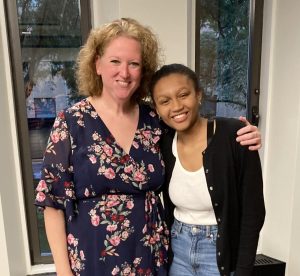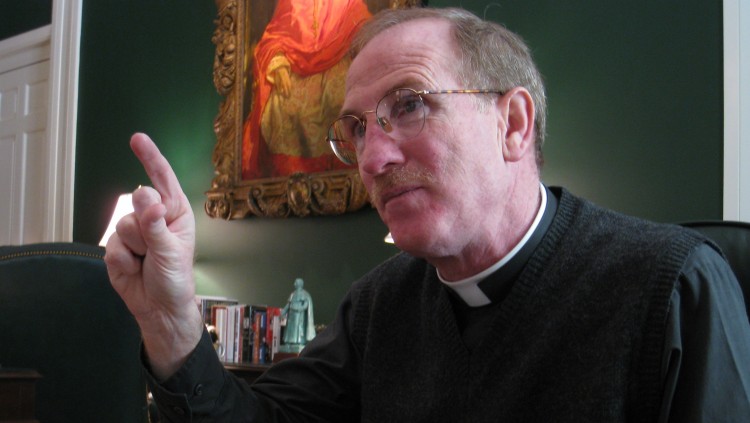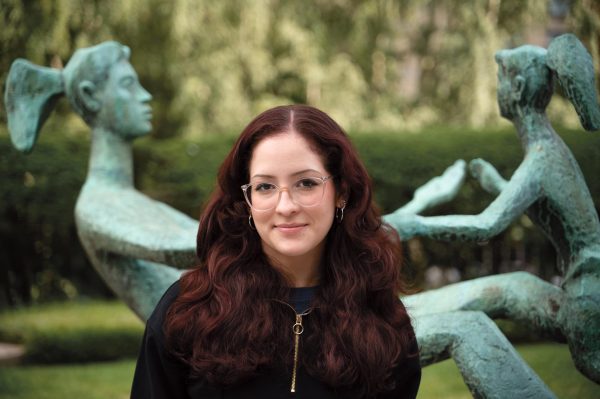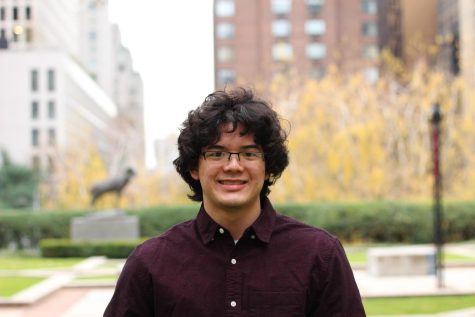Asylum Seekers Protest Removal from Lincoln Center Area
The migrants were protesting for accessible and sustainable housing after touring a new emergency site, resisting the city’s order to relocate from the hotel on West 57th Street
Protesting asylum seekers ate hot food provided by mutual aid groups.
February 10, 2023
Following New York City’s decision to relocate asylum seekers from their temporary residence at The Watson Hotel, migrants protested outside the hotel for six days before they were removed by the New York Police Department (NYPD) on Feb. 1.
The hotel, which is located on West 57th Street, just three blocks from Fordham’s Lincoln Center campus, — has served as a temporary shelter for migrants since November 2022. The city’s decision forced migrants to relocate to a new shelter at the Brooklyn Cruise Terminal in Red Hook, which has been criticized by residents of the building and activists because they believe it is not safe, sanitary or accessible to the rest of the city.
The city started using The Watson as a Humanitarian Emergency Response and Relief Center (HERRC) for single adult male migrants. New York City has a decades-old “Right to Shelter” law mandating that the city provide adequate housing to all people experiencing homelessness, which includes asylum seekers. Many of the asylum seekers staying at the hotel had been bused into New York’s Port Authority Bus Terminal from Texas, creating a housing crisis in the city’s shelter system.
Sanctuary cities across the nation are struggling to accommodate the influx of migrants in the past year. According to a Politico article, Adams has asked Biden for support to fill a $2 billion deficit in New York’s migrant housing program.
Sanctuary cities across the nation are struggling to accommodate the influx of migrants in the past year. According to a Politico article, Adams has asked Biden for support to fill a $2 billion deficit in New York’s migrant housing program.
Migrants were evicted from the hotel on Jan. 27 after the city relocated them to the HERRC in Brooklyn. Following their forced removal, a group of migrants traveled back to The Watson the day they were evicted and began camping outside the hotel in protest of the conditions they had witnessed at the Brooklyn Cruise Terminal.
Some of the protestors said that they returned to the hotel from the Brooklyn HERCC because the new site failed to provide adequate hygienic facilities and personal security. The shelter at the Brooklyn Cruise Terminal is a hangarlike structure with hundreds of beds laid out in rows in an open arrangement, and migrants who had been sent there reported insufficient access to bathrooms and showers, fears of an outbreak of disease, and inaccessibility to reliable transportation to the rest of the city.
At the Watson Hotel, The Observer originally conducted interviews with migrants in Spanish which have been translated into English.
A group of migrants sleeping on blankets outside of The Watson Hotel were adamant that conditions were not sufficient at the new location. Carlos Espinosa, a migrant from Ecuador who protested the eviction, returned to The Watson after seeing the conditions at the Brooklyn HERRC.
“They sent us to a cage, like a pig farm,” Espinosa said. “We don’t have privacy, we’re constantly being watched. It’s like we went to a prison.”
After staying the night of Feb. 3 at the Brooklyn Cruise Terminal, New York City Mayor Eric Adams said that “the facilities at the Brooklyn Cruise Terminal are providing the same services to asylum seekers as every other humanitarian relief center in the city.”
Videos of the Brooklyn Cruise Terminal HERRC in Red Hook show rows of cots lined head to head, spurring concerns about privacy and safety for the individuals living there. The Mayor’s Office of Immigrant Affairs (MOIA) urged the migrants to return to the Brooklyn shelter, but the asylum seekers refused, demanding a secure, more sustainable housing option.
Manuel Castro, commissioner of MOIA, visited the migrants outside the hotel on the morning of Jan. 31. He said the city sent the men to the Brooklyn Cruise Terminal shelter because the city and its partners who work with asylum seekers are at capacity.
The city has been facing an influx of migrants since spring 2022, testing its shelter system. Kate Smart, a spokesperson for the mayor’s office, said that, as of Feb. 1, over 28,400 asylum seekers were in the city’s care.
“I understand that the priority is to obtain a work permit, so that people can work, be independent, find their own apartment, etc. That is our intention,” Castro told migrants and reporters at The Watson. “But as you already know, many people have come and the organizations we work with are at capacity, and that space [Brookly Cruise Terminal HERRC] is going to let us do more.”
The city has been facing an influx of migrants since spring 2022, testing its shelter system. Kate Smart, a spokesperson for the mayor’s office, said that, as of Feb. 1, over 28,400 asylum seekers were in the city’s care.
Following the notice to vacate, about 40 migrants lined up outside The Watson’s West 57th Street entrance day and night for six days, sleeping in blankets on the sidewalk. Groups of men who had befriended each other in Texas huddled together for warmth as mutual aid groups and volunteers provided them with food, hand-warmers, warm clothing and other resources.
“This is the same story of Ellis Island. This is the same story of my family, and it will be the story of our children.” Luna Gray, an organizer at South Bronx Mutual Aid
Luna Gray, an organizer at South Bronx Mutual Aid, was at the protest Monday night handing out food and supplies.
“No one has told them what to do. They are organizing this on their own,” Gray said. “And what are we organizing? A little bit of food and a little bit of support for whatever they decide to do.”
Gray said she supported the protestors because they reminded her of her own family.
“As a Latina Indigena, when I look at these people, I see my own cousins. I see my father who migrated here in the ‘90s from the Dominican Republic,” Gray said. “This is the same story of Ellis Island. This is the same story of my family, and it will be the story of our children.”
Buses en route to the Brooklyn Cruise Terminal were parked outside the hotel awaiting holdouts who decided to return to the new shelter.
“We are in agreement with the city accommodating kids and families but they should relocate us to a dignified site or housing accommodation.” Ivan Pereira, a Venezuelan migrant who was a leading voice in the group of migrants advocating for better living conditions
According to the asylum-seekers, the city provided a notice before their eviction that ordered them to vacate their rooms and either relocate to the Brooklyn Cruise Terminal or another NYC shelter. The city announced its plans to use the hotel to accommodate asylum-seeking families and children instead.
Ivan Pereira, a Venezuelan migrant who was a leading voice in the group of migrants advocating for better living conditions, said the residents were not asking to be accommodated back in The Watson.
He added that as a single father, he understood the city’s plans to house families and children at the hotel. According to Adams’ Feb. 4 press release, families have already begun to move into The Watson Hotel.
“We are in agreement with the city accommodating kids and families,” Pereira said. “But they should relocate us to a dignified site or housing accommodation.”
The asylum seekers who had toured the new Brooklyn HERRC with the commissioner said they were not convinced that the site would provide them with livable conditions.
The commute from the Brooklyn Cruise Terminal to Manhattan can be over an hour long, causing some migrants to worry about the isolated location. Many are concerned that it could cause difficulties maintaining the jobs they managed to find close to The Watson, and others are concerned about finding new jobs, which are limited as they wait to obtain work permits.
“I want to be here, have a place where I can sleep in peace so that I am able to go out in peace,” Pereira said. His goal is to “be able to go find a job, and be able to save money so that I can rent a room.”
On Jan. 31, Castro offered a small group of asylum seekers, including Pereira and Espinosa, a tour of the facilities at the Brooklyn Cruise Terminal in the hopes that it would convince them that it was an adequate place to stay.
“For me, it’s important that they understand that we’re doing this for them to be in a safe environment where they can access resources,” Castro said.
A few hours after a group of migrants departed for Brooklyn with Castro, the bus carrying them returned to The Watson. The asylum seekers who had toured the new Brooklyn HERRC with the commissioner said they were not convinced that the site would provide them with livable conditions.
Pereira expressed the group’s desire to continue the protest even though they felt like the city was not willing to work seriously with them to find a sustainable solution.
At the time of publication, MOIA has not issued an official press statement about the visit Castro made to The Watson on Jan. 31. The office tweeted that they believe that migrants are satisfied with the accommodations at the Brooklyn Cruise Terminal.
The protestors continued to stay outside the hotel, braving a flurry of snow the morning of Feb. 1. Pereira expressed the group’s desire to continue the protest even though they felt like the city was not willing to work seriously with them to find a sustainable solution.
Yorman Trejo, a Venezuelan migrant who stayed at The Watson for two months, said he believed that although the conditions at the Brooklyn Cruise Terminal are bad, it is an inescapable reality that asylum seekers must face.
“I am grateful that they gave us somewhere to stay,” Trejo said. “It lasted a short time, but I say that they gave us support already.”
Jackson Michell, a 48-year-old migrant from Peru who was accommodated in The Watson, said that he enjoyed his stay in the hotel but that was not what he was protesting for.
“I’m not saying that we should return to this luxury. I don’t want luxury,” Michell said. “What I am saying, my only way of thinking is that we should be in a place that is residential, where, for example, I can come home, and I can grab a slice of pizza nearby.”
“It’s absolutely horrifying, the treatment that migrants receive, especially if it’s on the undocumented side or the asylum side. I immigrated as a student on an F-1 visa, and even with that I did not receive the best treatment.”Isabel Piazza, FCLC ’23
Upon hearing about the migrants’ protest just a few blocks away from Fordham Lincoln Center, students expressed shock and concern.
Isabel Piazza, Fordham College at Lincoln Center (FCLC) ’23 and an international student from Peru, said she believes discrimination against immigrants is an issue in New York.
“It’s absolutely horrifying, the treatment that migrants receive, especially if it’s on the undocumented side or the asylum side,” Piazza said. “I immigrated as a student on an F-1 visa, and even with that I did not receive the best treatment.”
Abdual Yousef, FCLC ’24, read about the protest in the news. Yousef believes that the forced removal and displacement of migrants is disruptive to their lives.
“When people are forced to migrate and forced to move, they cannot land stable jobs, they cannot accumulate more wealth, so they can fulfill the basic needs and move on from the basic needs to something more fulfilling,” Yousef said.
He noted that while cities in the U.S. continue to expel and displace migrants, the country’s economy still depends on their labor.
“We continue to worsen their lives, and it has not just a bad effect on them, but also has a bad effect on us, in that the United States is heavily reliant on immigrant labor,” Yousef said.
Many of the migrants, including Pereira and Espinosa, rejected the city’s offer to stay in the shelter system, insisting on finding accommodations with what they deemed “livable conditions,” concerned for their safety and the cold.
NYPD conducted a sweep outside the hotel the night of Feb. 1, clearing out the protestors six days after the group began the demonstration. Police pushed back reporters and advocates outside The Watson as city sanitation workers discarded leftover blankets, paper- and plastic-ware, and signs expressing support for the migrants.
Further down the street, some of the migrants were loaded onto school buses provided by the city to transport them to the Brooklyn Cruise Terminal. As they piled suitcases into the backs of the buses, men who still refused to return to the shelter regrouped around the corner of West 57th Street, speaking among themselves and with activists about what to do next.
Many of the migrants, including Pereira and Espinosa, rejected the city’s offer to stay in the shelter system, insisting on finding accommodations with what they deemed “livable conditions,” concerned for their safety and the cold. Some were able to stay with friends or activists they had met through the protest. A small group secured plane tickets to Chicago with the help of activists on the scene.
“I want to keep fighting for the rights of immigrants. I want to keep fighting for those of us who had no say in the injustice of being suddenly kicked out of the hotel.” Carlos Espinosa, a migrant from Ecuador
Espinosa was determined to continue his advocacy despite the tense atmosphere and uncertainty many felt after the police sweep. He will stay with a friend in Westchester, but he does not believe his work in the city is done.
“I want to keep fighting for the rights of immigrants. I want to keep fighting for those of us who had no say in the injustice of being suddenly kicked out of the hotel,” Espinosa said. “And I want to keep fighting for the rights which belong to us.”














